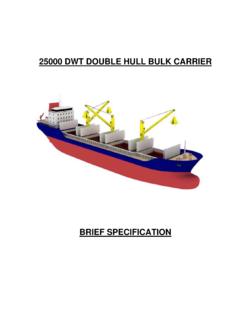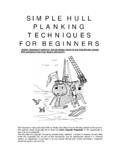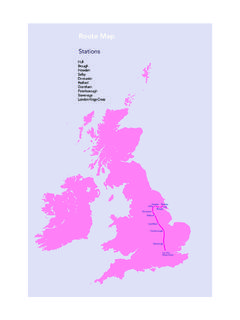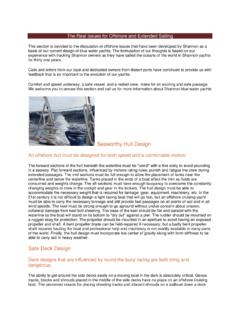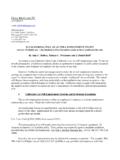Transcription of Fairing a Boat (inside and out) - OrcaBoats
1 Fairing a boat ( inside and out) Photo #1 Photo #2 Photo #3 Fairing a hull is more than just sanding it smooth. It is the process of making the hull as true to the form shape as possible and round from sheer line to centerline with as few waves in the hull as possible. How well you building your hull and making sure strips were aligned well, will determine how much time and effort you now have to put in to fair your hull . Fairing Outside The first step in Fairing a strip boat is to remove the high points with a block plane set to remove a very fine shaving. Plane only over the high points where strip meets strip and you can feel ridges. It is best if you turn the plane on an angle. (Photo #1) If you feel the plane catching grain going in one direction, plane in the other so as not to tear out pieces of your hull , since these will have to be filled. Once you are satisfied and you don t feel any obvious ridges, you can move to scraping the hull with a curved cabinet scraper to get into the convex areas.
2 (Photo #2 and #3) At this point is it probably to your advantage to go over the hull and fill and cracks that have appeared with a mixture of a fast set epoxy and saw dust to match the colour of your boat . Remember that your boat color will darken considerably once you apply glass and epoxy, so judge accordingly. You can also use pre-colored wood fillers, but is it recommended that you use epoxy as it also glues strips together that may have a space between. Let the epoxy fully harden over night. (Photo #4) Use your cabinet scraper to remove any epoxy on the hull of your boat before moving to sand paper. Since the epoxy is much harder than the wood, you risk removing too much wood and very little epoxy with the sandpaper at this point. You can now proceed to Fairing you hull . For this you will need a Fairing board. (Diagram #1) It is best made from a 1/8 inch thick piece of plywood or a more flexible board material. It Photo #4 Photo #5 Photo #6 needs to bend slightly.
3 You can purchase speed boards at auto body supply outlets and even some auto supply parts stores, but making one is easy. Take a piece of 120 grit sandpaper and cut it in half lengthwise and glue end to end on the middle of your board with contact cement or a spray adhesive. By using contact cement you will be able to peel the paper off and replace with new. Note: remove sand paper from your board when you are finished before contact cement fully dries. With the board on an angle and across the centerline of your boat , you can sand the hull by rocking the board or bending it over your hull . (Photo #5 Note good quality dist filter mask) This will create small scratches in your hull , but these will be removed with your orbital sander later. It is imperative that you remove as little wood material as possible to make the hull round. Be careful over sharp curved areas around the keel line and stems. This area is best sanded by hand.
4 Once you have the hull as smooth and round as you wish, you may need to go back and fill a few more cracks that have appeared and repeat the procedure for removing excess epoxy. Be sure to fully re-sand these areas. Wet the hull down with a water soaked rag or sponge. This will swell the wood and raise the grain. Once dry, you can begin to sand with 80- grit sandpaper on an orbital sander or sand by hand going with the grain only. Move to finer grit sandpaper. You should probably wet the hull down several times. When wet, you will easily see areas that require more sanding. Some builders go as high as 220-grit sand paper, but this may not be necessary. 120 or 150 will suffice. Do not wet the hull down after your final sanding. You are ready for glassing. Repeat this procedure for the outside of you deck. Fairing inside Fairing the inside of a boat is much more difficult and harder on your back, so it is helpful to have a few specially made tools for the job.
5 The curved cabinet scrapers will be of most use. The inside need not be as smooth as the outside. You mostly need to remove any steps or ridges between strips so that the fiberglass cloth does not bridge any gaps. Air bubbles are likely to form in these areas. To remove the most material quickly, you can Photo #7 Photo #8 make you own curved plane. Purchase a small wood sole plane and remove the blade. Plane down and sand the wood sole so that it is slightly rounded. (Photo #6) Replace the blade and mark the cutting edge to indicate what shape to grind the blade. Since you have opened the throat of the plane, you may need to add a metal or wood shim to hold the blade in position. This handy little tool will cut down a lot of backbreaking work. Following the plane, move to your curved cabinet scrapers, scraping only with the grain. To work in the tight areas, there are multi shaped scrapers on handles that work wonders. (Photo #7) Since people are likely to see inside your cockpit and inside hatches, you may choose to scrape these areas smoother for a nicer finish.
6 Once you are happy there are no ridges, move to sandpaper as you did for the outside Fairing job. By adding a small piece of curved foam to a sheet orbital sander, the process will be sped up. (Photo #8) Other options are to wrap sandpaper around a smooth bottle or shape a sanding block from wood. Follow the wetting down procedures as above and sand only with the grain. Fairing the inside of your deck is the same procedure. The only area on the inside of your deck that people will see is the undersides of the hatches and possible the sides inside the cockpit area, depending on hull shape.
